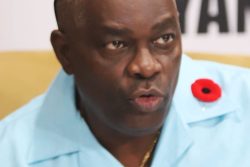One would have thought that after the 2005 flood crisis our politicians might have learned a few basic lessons, but it seems that they are endowed with a unique capacity to forget the things they should remember. Following any large-scale flood all the right noises are made about what had not been done, what should have been done and what will now be done to prevent it from happening again. And then everything is conveniently forgotten until it does happen again. So there should be no surprise that we are currently looking at inundations affecting all the regions, with the loss of livestock, property and crops which this inevitably involves.
Guyana is a hydraulic society; on the one hand it has to keep the sea from inundating its low-lying coastland and on the other during periods of heavy rainfall it has to be able to drain off the land efficiently. Those who went before us constructed our sea defences to keep the waters from the ocean in their place, and where the land is concerned, created an intricate system of canals which utilising gravity drainage emptied into the sea at low tide via kokers.
Even then, our more practical predecessors knew that it was impossible to keep the land absolutely dry at all times, particularly on those occasions when the intensity and duration of the rainfall exceeded the capacity of gravity drainage to cope. Periodically, of course, the sea too makes unwelcome visitations, but that is a problem of a different order. Where the land is concerned, previous generations allowed some areas to remain uncultivated in order to act as a kind of reservoir for the water in periods of unusual rain; in that way, the cultivated and settled areas were afforded some protection from flooding.
With respect to Black Bush Polder, a letter writer in this newspaper recently asked whether the cultivation of Kokerite Savannah had played any role in the flooding there. Originally intended to remain uncultivated to act as a receptacle for excess water, the writer said that permission had been given to “selected farmers” to grow cash crops, whereas previously it had only been used for cattle farming. They cut the dam, it was alleged, and installed tubes so they could drain the land, as a consequence of which “huge amounts of water got dumped … into the drainage system” which couldn’t handle it.
It might be noted that in 2013 Region Six Chairman David Armogan was reported as saying that legal action would be taken against eight farmers in the Kokerite Savannah who had ignored notices asking them to desist from pumping water into the Black Bush Polder irrigation system. He went on to be quoted as saying, “As soon as we get water out of the system, water is pumped back from the Kokerite Savannah into the system.” The change in utilisation of the land was said to be engaging the attention of the Minister of Agriculture.
Exactly what came out of Mr Armogan’s efforts is not clear, but now, eight years’ later, the same allegation is being made again. It is not just changes in land use, however, which are at issue; as was pointed out by engineers following the 2005 flood, new housing projects had been sited on natural flood terrain, without the accompanying drainage to give them, or the surrounding areas, sufficient protection from being deluged in years of heavy, prolonged rainfall. Since the water had nowhere else to go, it cascaded down the roads and then was siphoned off into the yards which were of lower elevation.
There are other issues too which are an echo of what transpired in 2005. Yesterday, Director General of the Civil Defence Commission, Lieutenant Colonel Kester Craig told the media in respect of Regions Two, Three and Seven that the lands were unable to drain efficiently because the affected areas were located in basins which were already water-logged. But the situation had been exacerbated by poor drainage caused by the lack of maintenance together with damaged and inefficient infrastructure, he said. As expected, the National Drainage and Irrigation Authority, among others, had been duly dispatched to undertake remedial work. It seems gratuitous to observe that effecting remedial work to a damaged and/or imperfect system does not deal with the fundamental problem.
It might seem that we need a comprehensive review of our current coastal drainage structures, taking as a starting point the various reports which followed the 2005 Great Flood, which admittedly did not affect the entire country as is currently the case. The arrangements for certain interior locations would have different principles, such as the Rupununi savannahs, which have a long history of flooding. In addition there is Georgetown, which is a special case and where the government has confused politics with drainage. But that is another story. The first thing, however, is to ensure there is adequate infrastructure in the country at large. Some critical places will need the assistance of mechanical pumps, which already exist in some places, although as several engineers have explained, they do not drain as much water as the gravity process.
The second thing is the matter of maintenance, where we have had a poor record over many decades. The systems for maintenance must be fit for purpose, and there must be continuous monitoring. We should not be in a situation where waterways and drainage canals have become silted up and no one bothers to ensure a free flow of water. The responsibilities of the various agencies whether local or national in relation to the trenches, etc, must be understood, and those found derelict must be held accountable.
The third thing which was emphasised very strongly in 2005 was the question of the dumping of garbage in the canals and trenches. It is fashionable to blame citizens for this, but the truth of the matter is there is no regular or efficient garbage collection in many areas. It is time the government retained someone to look at the problem of refuse collection and disposal across the whole country and see what the options are. Garbage filled waterways are a major impediment to effective drainage, but residents will take the easy way out if they think there are no alternatives.
The fourth thing is that there must be accountability irrespective of political considerations; politics is an impediment to effective drainage. By extension where appropriate, the law must be enforced, whether that involves farmers illegally pumping water into an irrigation system, or some other transgression in relation to contracts for maintenance, for example.
The fifth thing is that the government needs to commission a report on what this country can expect in terms of climate change, not forgetting, of course, rising sea levels. It might talk glibly about a new city, but that will not help the thousands of farmers who make their living along our coastland in particular, but also in Indigenous areas. They are already putting the West Bank at risk with the destruction of mangroves, so is it that they are prepared to write off agriculture? Or is it that they just haven’t thought about the consequences of more frequent and heavier rainfall patterns? What exactly is in their mind?
With generations of experience to draw from, the Guyanese population is remarkably well informed about drainage; it is up to them to keep an eye on officialdom where this is concerned, and raise their voices when they see things going wrong or not being done. In the end, it is their livelihoods which are at stake.





